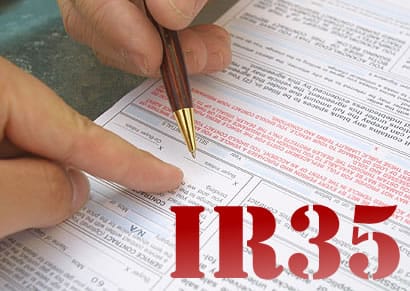HMRC publishes new IR35 test
HMRC has begun the process of overhauling its operation of the IR35 regime for personal services companies with new guidance that sets out some basic risk factors that will affect a contractor’s chances of being investigated. This overhaul will mean an increase in the number of IR35 investigations, the tax department confirmed.
The new guidance includes 12 business entity tests, each one receiving a different score, and they are designed to build up a picture of how a contractor’s business works and how they provide their services. These tests and their individual scores are:
- Business premises test - Does the business own or rent business premises separately from the contractor’s home or end client’s premises? (10 points if yes)
- PII test - Does the contractor need professional indemnity insurance? (2 points if yes)
- Efficiency test - Has the business had the opportunity in the past two years to increase its revenue by working more efficiently? (10 points if yes)
- Assistance test - Does the business employ any workers who bring in at least 25% of the yearly turnover? (35 points if yes)
- Advertising test - Has the business spent over £1,200 on advertising in the past year; entertainment does not count as advertising (2 points if yes)
- Previous PAYE test - During the past year, has the end client engaged you with no major changes to your working arrangements (Minus 15 points if yes)
- Business plan test - Does your business have a business plan with a regularly updated cash flow forecast, and does it have a business bank account, identified by the bank as such and separate from your personal account? (1 point if yes to both parts of the question)
- Repair at own expense test - Would the business have to bear the cost of rectifying any mistakes? (4 points if yes)
- Client risk test - During the past two years, has the business been unable to recover payment amounting to more than 10% of yearly turnover? (10 points if yes)
- Billing test - Does the business invoice for work carried out before being paid and negotiate payment terms? (2 points if yes)
- Right of substitution test - Does the business have the right to send a substitute? (2 points if yes)
- Actual substitution test - Has the business hired anyone in the previous two years to do the work it has taken on? (20 points if yes)
The scores used to assess contractors’ risk profiles are as follows:
Less than 10 points - High risk
10-20 points - Medium risk
More than 20 points - Low risk
These tests are not set in stone however, and they are an extension to the risk-based approach using by HMRC in all of its investigations and the existing ESI tool that HMRC has been providing for a while. The business entity tests are something that can be used to self-assess and see how one scores according to HRMC internal rating. In other words, they are just a diagnostic tool. The actual application of IR35 will always come down to employment status factors that must be tested against case law going back to the 1968 Ready Mixed Concrete decision.
Along with the new guidance, HMRC is drawing together specialist IR35 teams at offices in Salford, Edinburgh and Croydon to pilot the new approach to investigations. The objective of the exercise will be to address the risk of avoidance of employment taxes, including National Insurance. It means that there will probably be an increase of the number of investigations opened for IR35 reasons over the coming years.



